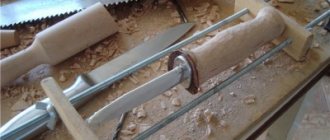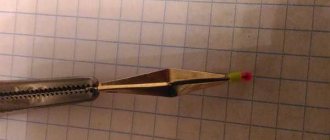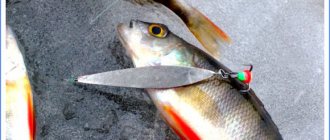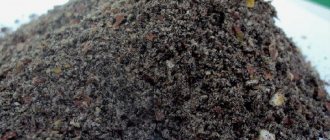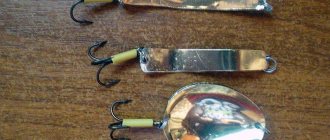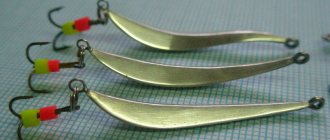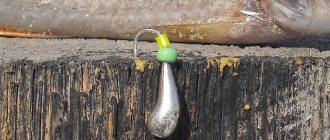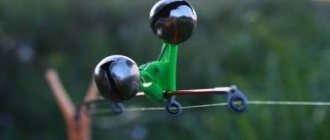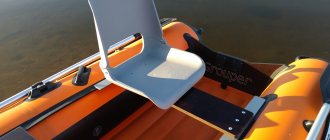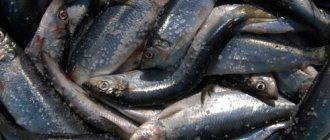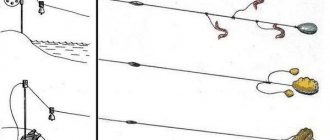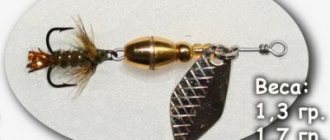The shelves of fishing stores are littered with a wide variety of spinners, but many fishermen nevertheless prefer to make spinners themselves with their own hands. One of them is a master of fishing, Ivan Pimenov.
Advantages of homemade turntables
About twenty years ago, when I was just trying to make my first spinner, it was very difficult to buy a good bait. It’s true that even today, with all the abundance available, choosing a catchy spinner is not much easier. All industrially produced baits are quite standard, and all reservoirs and the fish that live there are individual, and it is simply impossible to take into account these special fishing conditions during industrial production. Moreover, this is true not only for spinners, but also for other baits.
By the way, this is precisely the reason that the “Cheburashka” weight is used much more often than standard jig heads. For example, when a small perch bites at great depths, you need to put a small twister on a load of 20–25 grams, and there simply aren’t any jig heads of that weight with a suitable hook. That's why many fishermen switched to Cheburashkas, which can be equipped with any bait. Similar situations happen when fishing with spoons.
For example, in the middle of summer, in the heat of the day, the predator is best caught along the riverbed using spinners weighing 7–9 grams, but with a small petal. And industrial spinners of this weight are produced with blade No. 2-3, but they are not suitable - in the heat the predator is very reluctant to take large baits.
There are other reasons for using homemade turntables. A significant part of industrial baits are designed to a greater extent to attract the attention of fishing buyers, rather than fish: how much of a spinner is a catcher is still a second question for manufacturers. And for those who make turntables with their own hands, the main task is precisely catchability.
Pinwheel preferences
Among the various spinning lures, spinners come first for me. These are the most universal baits: depending on their size, they are suitable for catching both bleak and seasoned pike. The weight of spinners usually ranges from 0.5 to 20 grams, but personally I prefer to fish with small spinners weighing up to 7.5 grams.
Moreover, it must be taken into account that the size of the caught fish is not always directly related to the size of the spinner - very often large specimens are caught on small spoons. This is explained by the fact that in attracting a predator, the main role is played not by size, but by the vibrations that the spinner creates during wiring.
Spinners can be front-loaded, center-weighted, or have no loading at all. Of all the options, I prefer front-loaded turntables with an asymmetric weight head. Compared to other rotating spoons, they have several advantages: the ability to fold in flight increases the casting range without the tee getting tangled, and thanks to the asymmetrical head, they do not twist the line when retrieving. In addition, front-loaded spinners begin to work immediately after falling into the water. With them it is easier to find fish that are half-water.
But not all front-loaded spinners catch fish well. To make a truly catchy spinner, it is necessary to take into account a number of details on which the catchability depends. Most of my homemade spinners consist of a weight head with a metal leader, a central axis, a clamp, a petal, a cambric with a bead and a tee.
Head weight with leash
The head weight is cast together with the leash. The shape of the load can be different, but always asymmetrical, pointed in the front and thicker in the back. The length of the wire leash is 6–8 cm. The rear end of the leash forms a loop on the upper side of the back of the weight head: this loop serves to secure the rest of the turntable.
I have molds for weight heads weighing from 2.5 to 21 g, but mostly heads of 2.5, 4.5 and 7.5 are used, rarely 11 g. Heavier ones are rarely used in our conditions. Although heavy spinners work quite successfully, it is better to use jig baits instead: losing a jig head with a silicone bait on a hook is not as offensive as a good spoon.
Painting the heads is a troublesome, but, in my opinion, useless task that has virtually no effect on catchability. What really matters is the diameter of the wire used. All industrial turntables, as a rule, have very thick wire with a diameter of 0.8–0.1 mm. On the one hand, this increases the strength of the spinner, but on the other, it reduces catchability. And that's why.
There was a bite, say, a pike grabbed the turntable. The tee is in the mouth, and the end of the spoon is outside. When the pike begins to scurry from side to side, the thick wire acts as a lever, tearing the spinner out of its mouth, and the pike often frees itself from the hooks and walks off. But if a thinner wire is used in the design of the turntable - no more than 0.4-0.5 mm - this never happens: the wire simply bends without turning into a lever. The main task is to catch and pull out the pike, and the bent wire can then be straightened and fished further.
Fishing for pike with a spinning rod - 15 best videos
A vibrating tail and a spinning spoon on a small river from a boat. Practice spinning pike fishing in the fall. The video shows the wiring of two different types of baits and the fishing technique.
Fishing on a large reservoir. About choosing a fishing spot, adjusting the clutch before fishing and in detail about the unpopular type of spinning jig equipment - a vibrating tail on a lead corkscrew with a red tee.
Fishing with homemade mandules in the spring of 2021. Vivid footage from spinning pike fishing in early spring. Fishing with both a vibrotail and the recently popular bait – mandula.
Early spring on a micro river. March footage from a reservoir where the ice is rapidly disappearing. The bait is a bright fluorescent red twister on an offset hook with a jig head.
Summer fishing with Dragon spinners. In this video you will see footage from summer pike fishing with spinners from Dragon. Models: Carina, Viper, Aglia nr1 2.
On an artificial duckling in the summer. If you are not serious about such exotic types of artificial spinning baits as ducklings and frogs, then watch this video. There was almost a complete absence of bites on other baits, but as soon as I put in a duckling of the Savage Gear 3D Hollow Duckling model (10 cm / 40 g), a series of bites immediately began.
Autumn fishing with spinners. Again, the Dragon spinners from the same author of the video channel about fishing showed themselves well. Footage from pike fishing in the fall on the Desna River.
In autumn, use silicone baits. Twisters and vibrotails in pike fishing in the coastal zone at shallow depths. Despite the fact that the fishing was from a boat - the fish did not take at depth, the author of the video decided to try his luck in placing silicone baits at shallow depths, which gave a positive result. Pike 700 g and 1 kg.
Twitching pike with Minnow wobblers with detailed comments throughout the fishing. The author of the video floats a boat downstream and catches pike by twitching Minnow wobblers. All brands and models of wobblers are listed in the video. This is Usami Ebisu and Jackall Magsquad 115.
These wobblers look like this:
Fishing with poppers. An ambiguous bait that many try to catch, but nothing works. The author of the video showed by his own example that the popper bait is underestimated and it can provoke pike to bite frequently.
Retractable leash. Despite the fact that the retractable leash is considered an absolutely non-pike spread spinning rig, this video is a clear demonstration that while hunting perch, a pike can also bite
It is worth paying attention to the choice of fishing location and fishing technique. Fishing is carried out in winter in January!
Tips for choosing places for pike fishing and finding a future point on unknown bodies of water. Although the footage in the video was filmed in the lower reaches of the Volga, where there are much more fish than in the central regions of Russia, tips on finding the toothy predator are still very valuable.
Pike on ultralight. Armed with an ultra-light spinning rod, you can catch not only perch, but also pike. The author of the video talks about the correct choice of place for such fishing, the selection of gear and the ultra-light baits he uses, weighing several grams. How to make the correct retrieve with such an elegant tackle, and how to behave after biting not the weakest predatory fish - you will learn by watching the following video.
Home video about Chinese wobblers. Japanese original models of this type of lure often cost more than 600 rubles, and it’s a shame to leave that kind of money after catching a wobbler on a snag or stones. There is a way out - buy Chinese wobblers from Aliexpress at a significant discount. These are copies, not originals. Do they have the same properties as branded models, and can you fish with them as effectively as the manufacturer claims... The author of the next video will tell you about this.
pinwheel petal
The main part of any spinner is the petal. His work ultimately determines the catchability of the spinner. When I started making spinners, there was a big problem with good spinners. I started by copying Mepps turntables. I didn’t have a stamp, which is probably why the copies weren’t very successful. I decided to make my own options. The result was a petal that I still use in my homemade pinwheels.
The petals of most industrially produced spinners have a “regular” shape - a derivative of a sphere, cylinder and cone. When rotated, it creates relatively uniform, “monophonic” vibrations. And the surface of my petal has at least four distinct areas, plus an additional convexity, and part of the surface is slightly concave. It may not be very attractive to look at, but when rotating in water, the waves from the “edges” of such an “irregular” petal create real “polyphony”, which the “correct” industrial petal never has.
The material for the petal can be any non-ferrous metal. Most often I use cupronickel, brass, and beryllium bronze.
When choosing the thickness, it is necessary to take into account that a thicker petal rotates more slowly, and very thin ones are too unreliable in operation: it happens that a pike crushes the thin petal of the pinwheel when gripping it. From experience I can say that the optimal petal thickness is 0.4–0.45 mm, in extreme cases 0.5 mm.
I never make pinwheels in batches, so I don't use any stamps. I knock out the bend of the petal with a ball from a large bearing. At the same time, the metal is cold-worked, and this secures the profile given to the petal. In the middle of the petal I make a small bend, which allows me to change the angle of deflection of the petal while fishing.
If you reduce the bend angle, make it sharper, the angle of deviation of the petal from the axis will decrease, and the rotation speed will increase. If you straighten the petal, making it flatter, the deflection angle will increase and the rotation speed will decrease.
A dispute often arises among fishermen: should the blade of the spinner be polished or not? I rarely polish the petals myself. The fact is that any metal is covered with an oxide film. If you need to make the pinwheel brighter, just take a little sand and rub the petal. This does not give a bright polish, but a natural shine to the metal. The exception, perhaps, is cupronickel, which darkens a little in water.
The polished cupronickel petal soon fades and acquires a golden hue. Under no circumstances should you clean it off: I did it once, and then I regretted it for a long time. But all this applies only to the outer side of the pinwheel petal; in any case, the inner side cannot be polished
Clamp for turntable
The petal is attached to the axis using a clamp. This is the smallest but very important part of the turntable. It is a curved metal, usually brass, strip 1–1.5 mm wide with two holes at the ends. As a rule, the clamp has a semicircular shape, but it can be changed. With a semicircular shape, the petal rotates at a minimum distance from the axis of the pinwheel.
If you give the collar a triangular shape, the rotation of the petal will occur further from the axis, its play will slow down somewhat, but will become wider, with more powerful vibrations. By changing the shape of the clamp, you can get two spinners with different playability, and taking into account the influence of the bend of the petal on the game, it turns out that without removing the spinner, you can get at least four different options for playing the spinner. Moreover, all design changes are made simply by hand, without the use of tools.
The holes in the clamp can be drilled and then chamfered using a slightly larger diameter drill. However, to do this you need to have several very small diameter drills and a suitable drill. There is another way to get the same result, but without these tools: holes are punched with a regular needle. On the reverse side, the metal is pulled out, a cone is formed, and it is ground off with a needle file.
After this, the workpiece is turned over and pierced in the same way with a needle into the outlined hole on the other side. Since a concave cone is first formed on each side, the hole is countersunk.
Countersinking of the holes is necessary, because no matter how you bend the plate, the clamp will still move closely along the axis and holes without chamfers can “rub” the wire. On the other hand, the play of the clamp, in my opinion, worsens the performance of the turntable.
If the wire diameter is 0.5 mm, then the holes in the clamp should be no more than 0.65 mm. True, such a minimum gap can lead to jamming of the petal, for example due to even a small grain of sand, but in practice this happens extremely rarely.
Design features of rotating spinners
For a predator, this type of spinner is attractive not only for its visual characteristics, but also for the powerful flow of vibration waves created by the rotating working body of the accessory. The design features of rotating spinners are based on the circular rotational movements of a tin petal loosely strung on a metal rod through the pressure of the water column when guiding the product, carried out by winding the cord with a tackle reel. The resistance of the petal to the flow of water creates vibration waves that arouse the active interest of the predator, which, together with periodic glimpses of a moving spinner, provokes the fish to attack the object.
Assembling the turntable
As a rule, I start assembling the pinwheel from the hook. The length of the cambric is selected depending on the size of the petal. The tee is attached to a wire, a cambric, a bead, and finally a clamp with a petal are put on. Then the distance to the head is measured and the length of the wire axis is calculated. To prevent the clamp from touching the load when rotating, you need to leave a gap several millimeters wide.
Then a loop is made, the wire is twisted - that’s the entire installation of the front-loaded turntable. The color of the cambric can be any, but bright is desirable. If you plan to catch perch, it is best to use a red cambric. On the smallest turntables, colored beads can be used instead of cambric.
When installing the turntable, you must ensure that the petal does not reach the tip of the hooks. How far should the tee extend beyond the petal? There are different opinions on this matter. Some people try to mount the spinner so that the edge of the petal almost touches the tip of the hooks - in this case the spinner turns out to be compact.
Others maximize the distance from the petal to the hook. In my opinion, the best option is for the petal to cover the tee ring.
The plumage of the tee can make the turntable more attractive. Red threads are used for this. Pike and perch love this kind of “decoration”, but here you need to use moderation, the plumage should be minimal: two woolen threads on the forearm and a small tail.
The described installation of a pre-unloaded spinner is quite simple and universal, suitable for spinners of different weights and sizes, but it is far from the only one. When making micro-spinners weighing up to 1 gram, it is better to use installation with a central weight. Its role can be played by pellets.
